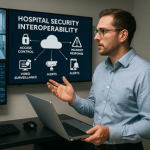
In the fast-paced environment of healthcare, where every second counts, having real-time data on the location and status of critical assets, patients, and staff can be transformative. Real-Time Location Systems (RTLS) are helping healthcare providers streamline operations, enhance patient safety, and improve overall efficiency. As the healthcare industry faces increasing demands and rising expectations, RTLS technology is becoming an essential tool to deliver quality care. In this article, we’ll explore what RTLS is, how it works, and the key benefits it offers in a healthcare setting.
What is RTLS?
Real-Time Location Systems (RTLS) use a network of sensors, tags, and software to provide real-time data on the location of people and assets within a defined area. In healthcare, this technology can be used to track medical equipment, monitor patient movements, and even manage staff workflow. RTLS typically involves a combination of wireless tags attached to items or worn by people, readers that detect signals from the tags, and software that processes and displays the data.
RTLS is versatile and can be implemented through various technologies depending on the healthcare facility’s needs and infrastructure. Common technologies include:
- RFID (Radio-Frequency Identification): Uses radio waves to track tags attached to objects.
- Wi-Fi: Leverages the existing Wi-Fi infrastructure for location tracking.
- Infrared: Provides precise room-level location accuracy.
- Ultrasound: Offers high accuracy and can be used for more specific, localized tracking.
- Bluetooth Low Energy (BLE): Allows for low-energy tracking ideal for battery-operated tags.
Key Applications of RTLS in Healthcare
RTLS has a wide range of applications in healthcare, from asset tracking to patient monitoring and workflow optimization. Here’s a closer look at how RTLS is making a difference in hospitals and other medical facilities:
- Asset Tracking and Management
Hospitals and healthcare facilities manage a large volume of equipment, from wheelchairs to ventilators and infusion pumps. Losing track of these assets can result in delays, increased costs, and patient care issues. RTLS provides real-time data on the location of these assets, ensuring that healthcare staff can quickly locate and access the equipment they need. Asset tracking also helps with inventory management, enabling facilities to avoid over-purchasing or under-utilizing resources. - Patient Flow and Safety Monitoring
RTLS can be used to monitor patient movements throughout a healthcare facility. This helps staff track patient flow, from admission to discharge, ensuring they receive timely care and are not waiting excessively for treatments or services. Additionally, RTLS can enhance patient safety by tracking vulnerable patients, such as those with dementia, and issuing alerts if they enter restricted areas or attempt to leave the facility unsupervised. - Staff Workflow Optimization
In healthcare, efficient staff management is critical to patient care. RTLS allows hospitals to monitor staff locations and identify patterns in workflow. This data can be used to optimize staff distribution, identify bottlenecks, and improve response times to patient needs. For example, RTLS data might reveal that nurses spend excessive time locating equipment or responding to specific areas, allowing administrators to make adjustments that enhance efficiency and staff satisfaction. - Hand Hygiene Compliance
One of the biggest challenges in healthcare is reducing healthcare-associated infections (HAIs). RTLS can help track hand hygiene compliance by monitoring staff interactions with hand sanitizing stations. When paired with sensors on hand hygiene dispensers, RTLS can log each time a healthcare worker uses the dispenser before entering or exiting patient rooms, allowing hospitals to monitor and enforce hygiene protocols. - Emergency Response and Evacuation Management
In the event of an emergency, knowing the exact location of patients, staff, and equipment is crucial. RTLS can help hospitals implement a fast, organized response by tracking real-time data on where everyone is located. This can be particularly useful in large facilities where coordinating an evacuation or response to a threat requires precise information.
Benefits of RTLS in Healthcare
RTLS offers numerous advantages for healthcare facilities, making it a valuable investment in modernizing operations and improving patient care. Here are some of the key benefits:
- Enhanced Patient Safety and Experience
RTLS directly impacts patient safety by allowing healthcare providers to monitor patient location, protect high-risk individuals, and ensure timely delivery of care. Patients experience shorter wait times, reduced delays in treatment, and greater peace of mind knowing they are in a secure, well-monitored environment. - Operational Efficiency and Cost Savings
With RTLS, hospitals and clinics can operate more efficiently, eliminating time wasted searching for equipment or personnel. By optimizing the use of assets and reducing the need for redundant purchases, RTLS can lead to significant cost savings. Facilities also benefit from having a complete overview of their operations, which helps in better resource allocation. - Infection Control and Hygiene Monitoring
RTLS can play an essential role in infection prevention by tracking hand hygiene compliance, monitoring high-touch equipment, and ensuring that contaminated equipment is appropriately isolated. This helps reduce the spread of infections within healthcare facilities, creating a safer environment for both patients and staff. - Data-Driven Decision Making
RTLS provides healthcare administrators with valuable data on how resources are used, patient movements, and staff workflows. This data can be analyzed to make informed decisions about process improvements, staffing needs, and equipment procurement, ultimately enhancing service delivery. - Improved Staff Productivity and Morale
By streamlining workflows and eliminating time-consuming tasks like searching for equipment or tracking down other staff members, RTLS helps healthcare professionals focus on patient care. This can reduce burnout and increase job satisfaction, as staff can spend more time on meaningful work rather than logistical challenges.
RTLS for Predictive Analytics and Preventative Maintenance
RTLS can also be integrated with predictive analytics to assist in the maintenance of healthcare equipment, helping facilities keep their assets operational and reduce unexpected downtime. Here’s how predictive analytics and RTLS work together to benefit healthcare facilities:
- Predictive Maintenance for Equipment: RTLS can monitor usage patterns of equipment like infusion pumps, defibrillators, and imaging devices, providing insights into when they may require servicing. Predictive analytics, combined with RTLS data, can alert staff when equipment is reaching its usage threshold or showing signs of wear, allowing for preemptive repairs.
- Reducing Downtime and Improving Lifespan: By addressing maintenance needs proactively, healthcare facilities can reduce equipment downtime, avoid costly repairs, and extend the useful lifespan of critical devices. This ensures that essential equipment is always available when needed, improving patient care and reducing operational costs.
- Optimizing Equipment Allocation: RTLS can help facilities identify underused or frequently moved equipment, allowing administrators to reallocate resources based on demand. This can lead to more efficient use of assets, reducing the need to purchase additional equipment and saving on expenses.
Patient Satisfaction and Experience Enhancement with RTLS
RTLS plays an essential role in enhancing patient satisfaction and providing a positive experience, as it helps healthcare facilities deliver efficient, personalized care. Here’s how RTLS supports a better patient experience:
- Reduced Wait Times: By tracking patient flow and optimizing scheduling, RTLS allows healthcare providers to reduce wait times, ensuring that patients receive timely care. This not only improves patient satisfaction but also enhances the facility's reputation for efficient service.
- Location-Based Services for Visitors: In large hospital campuses, RTLS can be used in mobile apps or kiosks to help patients and visitors navigate the facility. With location-based services, RTLS offers real-time directions, ensuring that visitors find their way quickly and reducing stress.
- Personalized Notifications: Some RTLS systems can notify patients or family members of estimated wait times, progress updates, or alerts if a patient is ready for discharge. These notifications keep patients and families informed, improving communication and providing peace of mind.
Data Security and Privacy in RTLS
Given that RTLS captures real-time location data for patients, staff, and assets, it is crucial to prioritize data security and ensure that privacy standards are upheld. Healthcare providers implementing RTLS should consider the following security and privacy measures:
- Data Encryption: To protect sensitive location data, RTLS systems should use encryption for both data at rest and data in transit. Encryption ensures that data cannot be accessed by unauthorized users, safeguarding patient and staff privacy.
- Access Control and Authorization: Only authorized personnel should have access to RTLS data. Implementing strict access controls, such as role-based access, multi-factor authentication, and periodic audits, can help prevent unauthorized access and maintain accountability.
- Compliance with Regulations: RTLS systems in healthcare must comply with regulations such as HIPAA in the U.S., which mandates the protection of patient information. Ensuring compliance with such regulations is critical for maintaining trust with patients and avoiding legal issues.
- Anonymization and Aggregation: To further protect privacy, healthcare providers can anonymize RTLS data or aggregate it to prevent individual tracking. For example, instead of tracking a specific patient, the system could provide data on patient flows and patterns without attaching it to identifiable individuals.
Challenges and Considerations for Implementing RTLS
While RTLS offers numerous benefits, implementing it in a healthcare setting comes with challenges. Understanding these factors can help facilities make a smooth transition to an RTLS-powered operation:
- Cost of Implementation: RTLS requires an initial investment in hardware, software, and possibly infrastructure upgrades, depending on the technology used. While this cost is often offset by the efficiency gains and cost savings RTLS brings, budget considerations are essential.
- Integration with Existing Systems: RTLS systems often need to integrate with other healthcare technologies, such as electronic health records (EHR) and patient monitoring systems. Ensuring compatibility and seamless integration with these existing systems is essential for effective use.
- Staff Training and Adaptation: Healthcare staff will need to learn how to use RTLS effectively, which requires training and adaptation time. Some employees may resist the technology initially, so providing clear explanations on how RTLS benefits them and improves patient care can help ease the transition.
The Future of RTLS in Healthcare
As technology continues to evolve, the applications of RTLS in healthcare will likely expand. The integration of RTLS with other advanced technologies, such as the Internet of Things (IoT), artificial intelligence (AI), and predictive analytics, holds great potential for healthcare. Here are a few emerging trends:
- Predictive Maintenance of Equipment: By monitoring usage patterns, RTLS can help predict when equipment will need maintenance or replacement, reducing downtime and preventing unexpected failures.
- AI-Powered Insights: RTLS data, combined with AI, can identify patterns and optimize resource allocation, improve scheduling, and forecast equipment needs.
- Patient and Staff Wearables: Wearable devices equipped with RTLS can further enhance patient monitoring and staff safety, providing real-time health data and ensuring quick assistance when needed.
With these advancements, RTLS will continue to transform healthcare operations, helping facilities become more responsive, patient-focused, and resource-efficient.
Conclusion
Real-Time Location Systems (RTLS) are redefining how healthcare facilities manage resources, monitor patients, and enhance staff productivity. By providing real-time data on the location and status of patients, staff, and assets, RTLS helps hospitals deliver high-quality care while improving operational efficiency and reducing costs. The ability to integrate RTLS with predictive analytics, improve patient satisfaction, and ensure data security makes it a valuable asset for modern healthcare facilities.
As the healthcare industry continues to evolve, RTLS technology will play an increasingly crucial role in meeting the demands for safety, efficiency, and data-driven decision-making. Healthcare providers looking to stay competitive and enhance patient care should consider RTLS as a strategic investment in their future operations. From tracking assets to enhancing infection control, RTLS is revolutionizing the healthcare industry—and its impact is only expected to grow in the years to come.
If you are interested in implementing RTLS or learning more. Contact SSP at sales@sspro.biz!


